Last-Minute NYC Holiday Gift Guide 🎁
We’ve created a holiday gift guide with presents for the intrepid New Yorker that should arrive just in time—


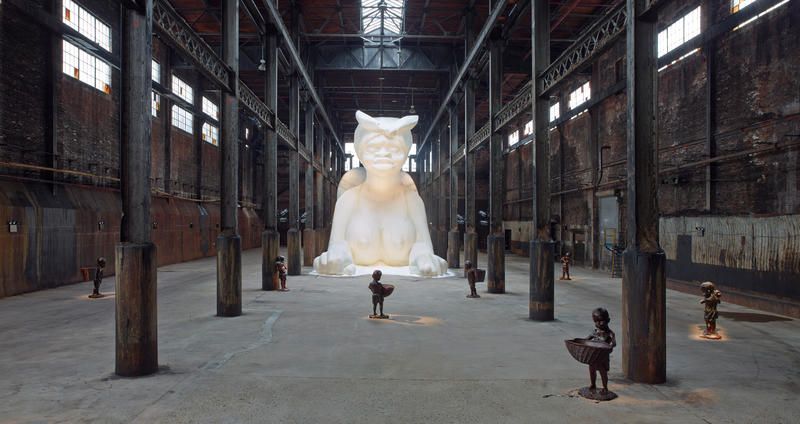
A project of Creative Time. Photo by Jason Wyche courtesy of Sikkema Jenkins & Co., New York. Artwork © 2014 Kara Walker.
While New York City is home to world renowned art institutions such as the Metropolitan Museum of Art and the Guggenheim Museum, stunning works of art are scattered in public places across the city. Many of us are already familiar with works like Isamu Noguchi’s Red Cube, Kristen Visbal’s Fearless Girl and most recently, Ai Weiwei’s Good Fences Make Good Neighbors. Some serve as centerpieces in parks, plazas and subway stations while others add a dash of color to seemingly forgotten areas, like empty lots and abandoned buildings. This wide variety of works — both temporary and permanent — add dynamism to the already thriving cultural hub that is New York City.
New Yorkers have various public and private art initiatives (Creative Time, Percent for Art and MTA’s Arts for Transit, etc.) to thank for what the Museum of the City of New York describes as “the most ambitious urban art programming in the world.” Presented to mark the 40th anniversary of the Public Art Fund, the museum’s latest exhibit, Art in the Open: Fifty Years of Public Art in New York, celebrates and chronicles the last half century of art and innovation across the five boroughs. It features over 125 objects, including pieces by Kara Walker, Keith Haring, Roy Lichtenstein, and Christo and Jeanne-Claude.
As a sneak preview of Art in the Open: Fifty Years of Public Art in New York, which runs from November 10, 2017 – Sunday, May 13, 2018, we’ve rounded up 10 highlights and notable works that are touched upon in the exhibition:
Artist and filmmaker Bill Brand’s Masstransiscope is one of those great serendipitous surprises to brighten up your commute. Installed by Arts for Transit in 1980, the piece works like a giant zoetrope (a type of animation that creates the appearance of motion as images inside a spinning cylinder are viewed through slits). In this case, Brand’s cartoon comes to life through the movement of the subway. It’s located in Brooklyn’s abandoned Myrtle Avenue subway station, which used to be a stop on the Brooklyn-Manhattan Transit line between Manhattan Bridge and DeKalb Avenue.
According to Brand’s website, the work “consists of a series of 30” high images housed inside a long wood and steel structure with narrow slits, through which the images are seen.” Restored in 2008 and in 2013, the artwork is painted on 300 feet of reflected material and the inside is illuminated by fluorescent lights. You can view it on the B and Q trains as they approach the Manhattan Bridge. Read more here.
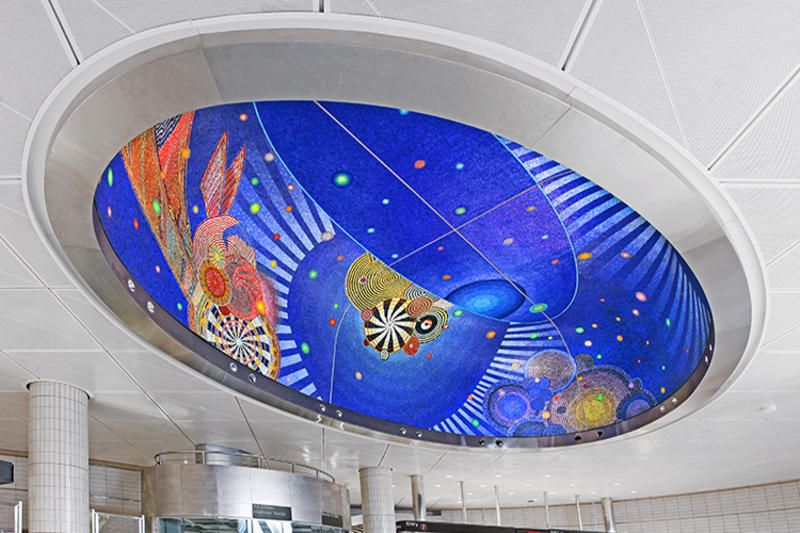
Funktional Vibrations (2015) © Xenobia Bailey, NYCT 34th Street-Hudson Yards Station. Commissioned by MTA Arts & Design
Situated in the curved ceiling dome above the main entrance of the 34th Street-Hudson Yards subway station (7 Train) is a majestic, glass mosaic, created by artist Xenobia Bailey. Commissioned by MTA Arts & Design, the work, entitled Funktional Vibrations, features overlapping mandala-like circles and bands of color that are set against a cobalt blue background. Against the shiny, industrial aluminum of the new station, it offers a brilliant pop of color.
According to the MTA website, Bailey sees her working as “speaking to the universal idea of creation.” As a fiber artist, she primarily works in crochet and textiles. As such, Funktional Vibrations began as crocheted designs, which were transferred to digital images and later interpreted into handcrafted glass tiles by Miotto Mosaic Art Studio.
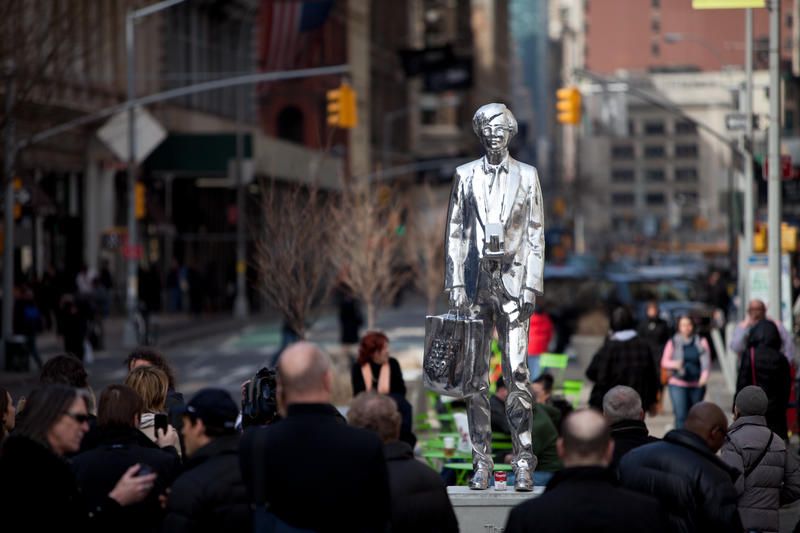
Rob Pruitt, The Andy Monument, Union Square, 2011. Photograph by James Ewing. Image courtesy Public Art Fund
A tribute to late artist, Andy Warhol, Rob Pruitt’s The Andy Monument once stood in Union Square, the site of Warhol’s studio, The Factory (1968 to 1984), where he and his fellow collaborators produced silkscreen paintings, films, music, books and a number of other works.
The Andy Monument, created through a technique that combined live model digital scanning and hand sculpting, was finished in chrome and mounted on a concrete pedestal. In describing his work, Rob Pruitt notes, “Like so many other artists and performers and people who don’t fit in because they’re gay or otherwise different, Andy moved here to become who he was, to fulfill his dreams and make it big. He still represents that courage and that possibility. That’s why I came to New York, and that’s what my Andy Monument is about.”
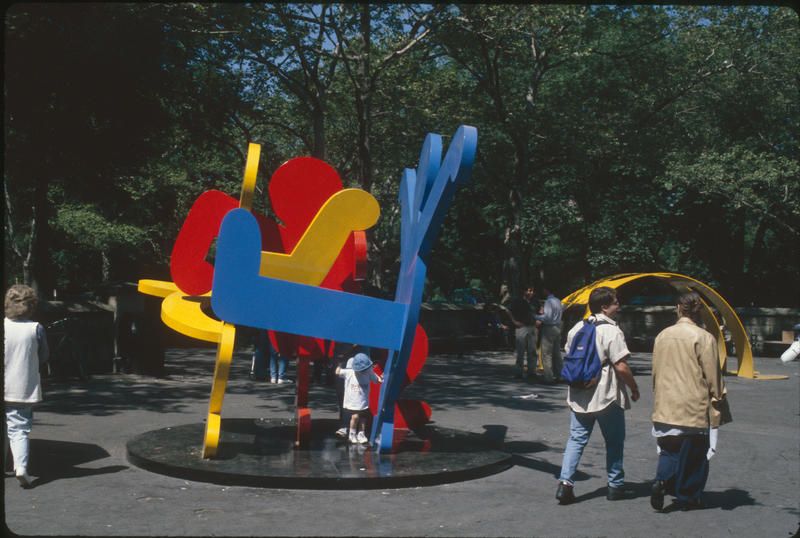
Keith Haring, Yellow Arching Figure, w/ Untitled (Three Dancing Figures), part of Keith Haring on Park Avenue, Doris C. Freedman Plaza, 1997. Photograph by Frederick Charles. Image courtesy Public Art Fund
On display at the Doris Freedman Plaza in 1997, Keith Haring’s Yellow Arching Figure, w/ Untitled (Three Dancing Figure) was part of Keith Haring on Park Avenue, the first comprehensive survey of Haring’s monumental sculptures that were created between the years 1985 to 1989. The exhibit included three large public sculptures that had never been seen in a public space in the United States.
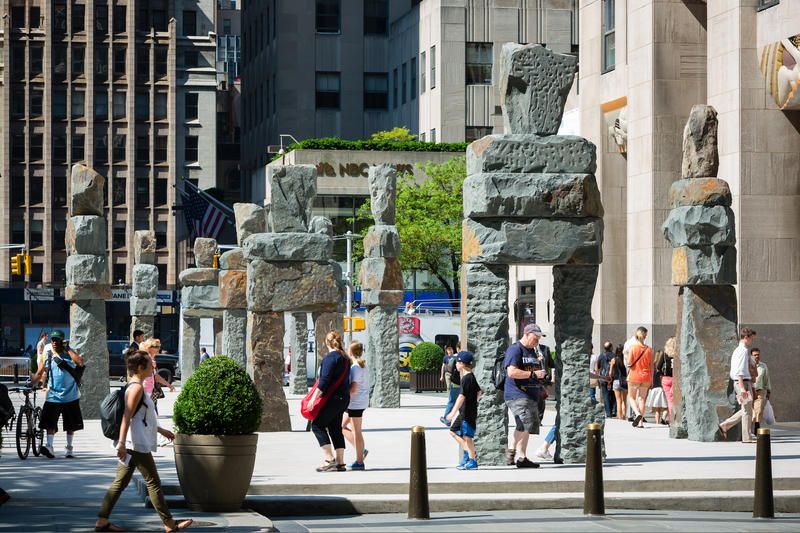 Ugo Rondinone, Human Nature, Rockefeller Center, 2013. Photograph by Bart Barlow. Image courtesy the Public Art Fund
Ugo Rondinone, Human Nature, Rockefeller Center, 2013. Photograph by Bart Barlow. Image courtesy the Public Art Fund
In 2013, Swiss-born and New York-based artist, Ugo Rondinone, created a series of nine colossal stone figures for Rockefeller Center. The piece, entitled Human Nature, was displayed along the full length of the plaza, between 49th and 50 Streets.
To put the immensity of the work into context, each sculpture ranged in height from 16 to 20 feet and weighed up to 30,000 pounds. Described as “ancient sentries,” the individual figures were crafted using slabs of bluestone, which were taken from a quarry in Northern Pennsylvania. Although they stood fixed in place, the sculptures represented a different human emotion (Sad, Calm, Ecstatic…) and viewers were able to walk between their legs.

A project of Creative Time. Photo by Jason Wyche courtesy of Sikkema Jenkins & Co., New York. Artwork © 2014 Kara Walker.
Kara Walker is most noted for her large silhouettes, which are cut from sheets of black paper. In 2014, however, she presented her first large-scale public project:
At the behest of Creative Time Kara E. Walker has confected:
A Subtlety
or the Marvelous Sugar Baby
an Homage to the unpaid and overworked Artisans who have refined our Sweet tastes from the cane fields to the Kitchens of the New World on the Occasion of the demolition of the Domino Sugar Refining Plant
The installation, taking the form of a massive female sphinx, was housed inside Brooklyn’s Domino Sugar Factory, once the world’s largest sugar refinery, now slated for redevelopment as office space, residential towers, and parkland.
Standing approximately 80-feet long by 40-feet high, the piece had a polystyrene core that was
coated in 30-tons of sugar. Several smaller childlike figures (attendants) were also cast from boiled sugar. It was only on display for two months, but you can now view Kara Walker’s sphinx study at the MCNY.
Photo by Jinwoo Chong for Untapped Cities.
Part of an ongoing series by Brooklyn-based artist, Hank Willis Thomas, The Truth Is I See You was an exhibition of various comic-book inspired speech balloon signs that featured phrases taken from a poem that was written in collaboration with artist Ryan Alexiev.
The phrases, described as “universal statement of truths,” were presented in 22 languages (with English translations and a pronunciation guide) and installed along the MetroTech Promenade in Downtown Brooklyn. Phases included proclamations like “The truth is I respect you,” and “The truth is I welcome you.” Two rolled-steel benches, a large-scale steel tree and, on occasion, the Truth Booth (an interactive video project) also accompanied the signs, giving visitors a space for contemplation.

From February 12 to February 28, 2005, artists Christo and Jeanne-Claude’s temporary piece, The Gates, was on display along the pathways of Central Park. The series of 7,503 gates with free-hanging saffron colored fabric panels stretched for 23 miles. The piece was described as “a golden river appearing and disappearing through the bare branches of the trees.”
The Gates instantly became a global phenomenon, which took millions of dollars and 25 years of planning to carry out. On view at the MCNY, are the Central Park map plans for the project.
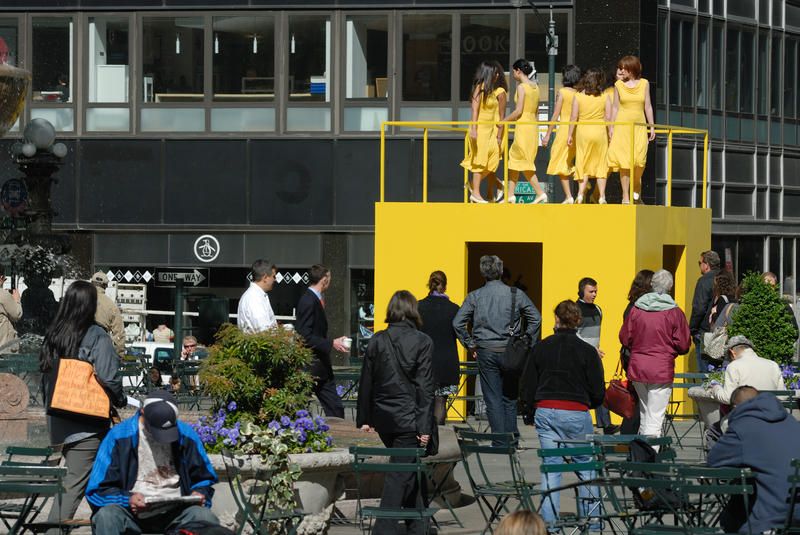
Kate Gilmore, Walk the Walk. Photograph by Amy C. Elliot courtesy Public Art Fund
In 2010, Kate Gilmore’s first live public installation, Walk the Walk, took place in Bryant Park. It featured a random sample of female office workers, who would take part in 5-hour shifts of improvisational choreography that included everyday movement (walking, shuffling, and stomping) on the roof of a cubic, yellow structure.
Participants had to wear beige shoes and yellow dresses as their uniform. Viewers were also allowed to enter the structure, where they could hear the sound of the movement above. Like everyday work routines, performances took place Monday through Friday from 8:30 am to 6:30 pm.
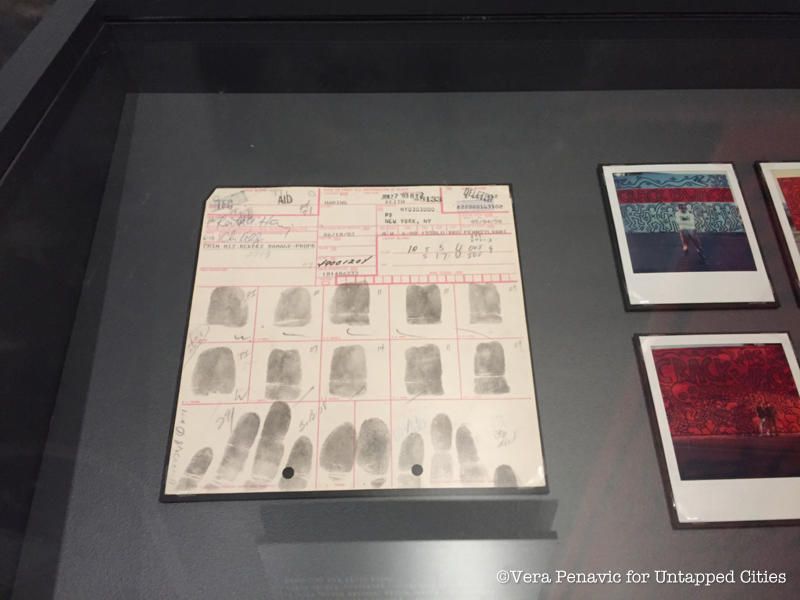
Another noteworthy highlight is Keith Haring’s fingerprint card, which the artist took from a police precinct following an arrest. According to the MCNY, Haring produced hundreds of chalk drawings in the subway between the years 1980 and 1985. His work, including Radiant Child and Barking Dog, eventually became a familiar sight for commuters. However, they also apparently led to his frequent arrest.
“Art in the Open: Fifty Years of Public Art in New York” is on view at the Museum of the City of New York from November 10, 2017 – Sunday, May 13, 2018. For more information, click here.
Next, check out 5 Fun Maps to Discover at the Museum of the City of New York and 10 of NYC’s Most Memorable Public Art Installations to Celebrate the 50th Anniversary of “Art in the Parks.”
Subscribe to our newsletter